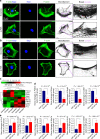Microenvironmental stiffness mediates cytoskeleton re-organization in chondrocytes through laminin-FAK mechanotransduction
- PMID: 35277477
- PMCID: PMC8917190
- DOI: 10.1038/s41368-022-00165-5
Microenvironmental stiffness mediates cytoskeleton re-organization in chondrocytes through laminin-FAK mechanotransduction
Abstract
Microenvironmental biophysical factors play a fundamental role in controlling cell behaviors including cell morphology, proliferation, adhesion and differentiation, and even determining the cell fate. Cells are able to actively sense the surrounding mechanical microenvironment and change their cellular morphology to adapt to it. Although cell morphological changes have been considered to be the first and most important step in the interaction between cells and their mechanical microenvironment, their regulatory network is not completely clear. In the current study, we generated silicon-based elastomer polydimethylsiloxane (PDMS) substrates with stiff (15:1, PDMS elastomer vs. curing agent) and soft (45:1) stiffnesses, which showed the Young's moduli of ~450 kPa and 46 kPa, respectively, and elucidated a new path in cytoskeleton re-organization in chondrocytes in response to changed substrate stiffnesses by characterizing the axis shift from the secreted extracellular protein laminin β1, focal adhesion complex protein FAK to microfilament bundling. We first showed the cellular cytoskeleton changes in chondrocytes by characterizing the cell spreading area and cellular synapses. We then found the changes of secreted extracellular linkage protein, laminin β1, and focal adhesion complex protein, FAK, in chondrocytes in response to different substrate stiffnesses. These two proteins were shown to be directly interacted by Co-IP and colocalization. We next showed that impact of FAK on the cytoskeleton organization by showing the changes of microfilament bundles and found the potential intermediate regulators. Taking together, this modulation axis of laminin β1-FAK-microfilament could enlarge our understanding about the interdependence among mechanosensing, mechanotransduction, and cytoskeleton re-organization.
© 2022. The Author(s).
Conflict of interest statement
The authors declare no competing interests.
Figures







Similar articles
-
Microenvironmental Stiffness Directs Chondrogenic Lineages of Stem Cells from the Human Apical Papilla via Cooperation between ROCK and Smad3 Signaling.ACS Biomater Sci Eng. 2023 Aug 14;9(8):4831-4845. doi: 10.1021/acsbiomaterials.2c01371. Epub 2023 Feb 16. ACS Biomater Sci Eng. 2023. PMID: 36797839
-
Substrate Compliance Directs the Osteogenic Lineages of Stem Cells from the Human Apical Papilla via the Processes of Mechanosensing and Mechanotransduction.ACS Appl Mater Interfaces. 2019 Jul 24;11(29):26448-26459. doi: 10.1021/acsami.9b07147. Epub 2019 Jul 10. ACS Appl Mater Interfaces. 2019. PMID: 31251564
-
Compliant substratum modulates vinculin expression in focal adhesion plaques in skeletal cells.Int J Oral Sci. 2019 Jun 1;11(2):18. doi: 10.1038/s41368-019-0052-3. Int J Oral Sci. 2019. PMID: 31152146 Free PMC article.
-
Roles of the cytoskeleton, cell adhesion and rho signalling in mechanosensing and mechanotransduction.J Biochem. 2017 Mar 1;161(3):245-254. doi: 10.1093/jb/mvw082. J Biochem. 2017. PMID: 28082721 Review.
-
FAK Structure and Regulation by Membrane Interactions and Force in Focal Adhesions.Biomolecules. 2020 Jan 24;10(2):179. doi: 10.3390/biom10020179. Biomolecules. 2020. PMID: 31991559 Free PMC article. Review.
Cited by
-
Mitochondrial Dynamics: Working with the Cytoskeleton and Intracellular Organelles to Mediate Mechanotransduction.Aging Dis. 2023 Oct 1;14(5):1511-1532. doi: 10.14336/AD.2023.0201. Aging Dis. 2023. PMID: 37196113 Free PMC article. Review.
-
The roles of Runx1 in skeletal development and osteoarthritis: A concise review.Heliyon. 2022 Dec 25;8(12):e12656. doi: 10.1016/j.heliyon.2022.e12656. eCollection 2022 Dec. Heliyon. 2022. PMID: 36636224 Free PMC article. Review.
-
The impact of matrix stiffness on hepatic cell function, liver fibrosis, and hepatocellular carcinoma-Based on quantitative data.Biophys Rev (Melville). 2024 Jun 3;5(2):021306. doi: 10.1063/5.0197875. eCollection 2024 Jun. Biophys Rev (Melville). 2024. PMID: 38846007 Free PMC article. Review.
-
Distinct cytoskeletal regulators of mechanical memory in cardiac fibroblasts and cardiomyocytes.Basic Res Cardiol. 2024 Apr;119(2):277-289. doi: 10.1007/s00395-023-01030-0. Epub 2024 Feb 13. Basic Res Cardiol. 2024. PMID: 38349539
-
Biomaterial-based mechanical regulation facilitates scarless wound healing with functional skin appendage regeneration.Mil Med Res. 2024 Feb 18;11(1):13. doi: 10.1186/s40779-024-00519-6. Mil Med Res. 2024. PMID: 38369464 Free PMC article. Review.
References
-
- Engler AJ, Sen S, Sweeney HL, Discher DE. Matrix elasticity directs stem cell lineage specification. Cell. 2006;126:677–689. - PubMed
Publication types
MeSH terms
Substances
LinkOut - more resources
Full Text Sources
Miscellaneous

